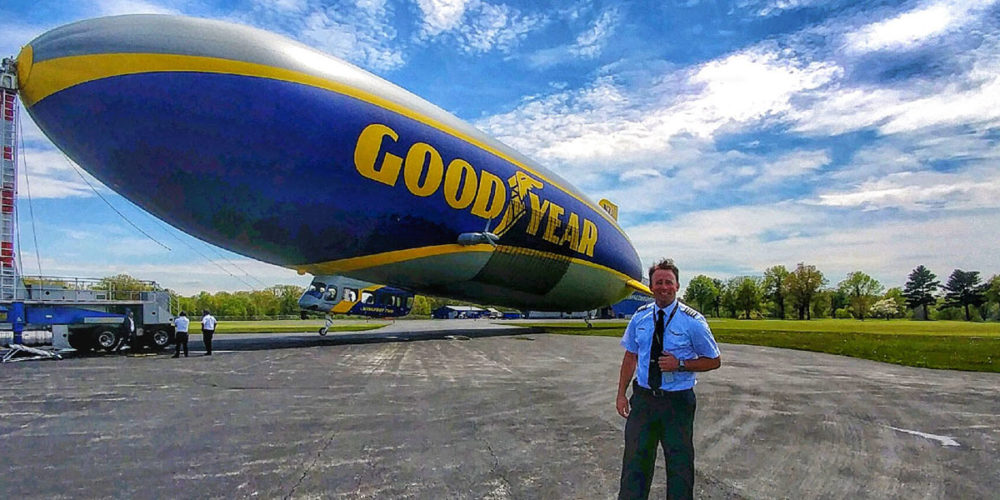William “Bill” Bayliss (’07, ’14, PC) wanted to be a commercial pilot, but he wasn’t a huge fan of automated aircraft systems. In 2013 he threw his fixed-wing training to the wind.
Now an employee of the Goodyear Tire and Rubber Company, Bayliss is one of only 10 airship pilots in the United States, and one of approximately 20 such pilots worldwide.
“I really like the older style of flying. I enjoy flying by the seat of my pants,” Bayliss says.
Flying a Blimp Isn’t for Everyone
Old-style piloting is just what Bayliss got when he started at Goodyear and learned to fly the last of two operating GZ-20A blimps. “It had control surfaces the size of barn doors,” Bayliss says. A cable and pulley system connected these control surfaces to a large wheel and rudder pedals in the cockpit. Depending upon the wind, it could take a lot of muscle to fly it, Bayliss says.
Another Embry-Riddle graduate, Matthew St. John (’96, DB), chief pilot at the Goodyear Airship operation in Southern California, taught Bayliss the ropes.
“There are no blimp simulators,” Bayliss says. “You need 200 to 300 hours in the seat to learn it. Blimping ain’t easy.”
Bayliss earned his airship wings on July 11, 2014, approximately nine months after starting his training. Earlier this year, Goodyear retired the old-school GZ-20A blimp from its fleet. “I was the last pilot ever trained to fly one of those airships. Now they’re in museums,” Bayliss says. “That’s kind of special to me.”
High-Tech Airship
In May, Bayliss passed his check ride on the new Goodyear Blimp. “It’s actually a semi-rigid airship, so it’s technically not a blimp,” he says. “It’s much more technologically advanced than the old GZ-20A.”
Goodyear operates two Zeppelin-designed NT (for new technology) airships, Wingfoot One and Wingfoot Two. A third is currently being built at the company’s Wingfoot Lake airship base in Akron, Ohio, and will complete the modern fleet in 2018.
The new airship model is larger, faster and more maneuverable, with three vectoring engines, four propellers and advanced avionics.
“Now it’s a glass cockpit, it’s all fly-by-wire,” Bayliss says. “But we still don’t have autopilot. You’re still flying the airship until you put it back on the mast.”
Despite its additional capabilities, the Zeppelin NT is challenging to fly. “There are 14 different controls for the engines on the center control pedestal, 15 if you include the side stick in takeoff and landing configuration,” Bayliss says. “You’re constantly adjusting the vectors and thrust. If you change one, you have to move another. You’re moving about four to five different levers on average during landings, including the air system and fuel system for trim.”
Public Relations Maven
Goodyear is known for being a public relations trailblazer, and its pilots are frontline ambassadors for the company.
“Goodyear has been operating airships for 100 years, 90 years for public relations purposes. We invented live aerial coverage,” Bayliss says. The first-ever live aerial coverage was provided by the Goodyear Blimp in 1955 at the Rose Parade in Pasadena, Calif.
The blimp pilot is part photographer, too. The airship and its externally mounted camera need to be positioned correctly to please the TV network directors on the ground.
“You have to get the right sun angle, and you have to watch out for that huge blimp shadow. You can’t put that [shadow] on the stadium or the field, or the director will yell at you,” Bayliss says. “Of course, you’re also talking to air traffic control and flying the thing. It can get pretty busy.”
Required: People Skills
In addition to advertising Goodyear tires everywhere it goes and providing aerial coverage for events, the airship flies corporate guests and invitation-only passenger flights, in addition to donating ride certificates to various charities near its three bases each year. “As a pilot, you’re part of the in-flight service team,” Bayliss says.
He says his experience at Embry-Riddle prepared him well for the many “hats” he wears now as assistant chief pilot at Goodyear. In addition to earning a B.S. in Aeronautical Science, an M.S. in Safety Science and working as an instructor pilot for six years at the university, Bayliss was a member the award-winning Prescott Campus Golden Eagles Flight Team. He was chief pilot and then president of the team when it won its first back-to-back national championship (2007 and 2008).
“I have no doubt that the Golden Eagles Flight Team prepared me — and not just for the flying skills, the precision landing and navigation, but also the leadership experience,” Bayliss says. “Hands down it had a huge role in my success and basically made me who I am today.”
Bayliss continues to support the Golden Eagles. In fact, when the team won its 11th national championship in May [see related story – link to Chatter NIFA story], the alumnus was there to help celebrate. “I drove down to Columbus [Ohio] and watched them win it. It was awesome. I was so proud to be a Golden Eagle and be there.”
A Blimp Pilot for Life
While many of his fellow Prescott Campus classmates are now flying for the airlines, Bayliss says he couldn’t be happier with his career path. “People are always smiling when getting on and getting off of my aircraft,” he says. “I think of myself as pretty lucky.”
He doesn’t plan on hanging up his airship wings anytime soon, either. “I’m going to do it for as long as they let me,” Bayliss says.
